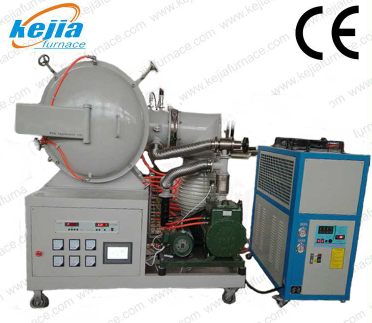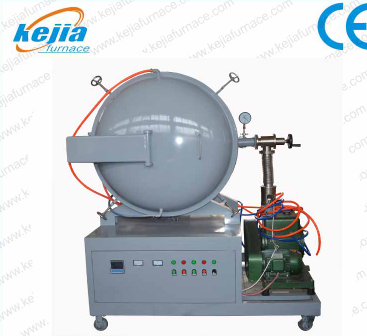Vacuum tempering furnace (vacuum tempering furnace) is a heat treatment equipment used to temper metal materials in a vacuum environment. It is widely used in aerospace, automotive manufacturing, mechanical processing and other fields, which can significantly improve the mechanical properties of metal materials, reduce internal stress and brittleness, and improve the toughness and reliability of materials. Let’s take a detailed look below!

Commonly used vacuum tempering electric furnace (click on the picture to view product details)
1. Working principle
The vacuum tempering furnace uses a vacuum pump to draw the interior of the furnace into a highly vacuum state, avoiding the influence of oxidation and pollution on metal materials. Then use electric heating wire to heat the metal material to the desired tempering temperature. The control system will monitor and adjust the heating process to ensure that the metal material achieves uniform tempering. After the insulation time is over, the metal material is rapidly cooled to room temperature through a refrigeration system to fix its structure and properties.
2. Structural composition
A vacuum tempering furnace usually consists of the following parts:
Furnace body: It is a square structure welded from steel sections and plates, and the interior is a furnace made of energy-saving refractory bricks, refractory fiber felt, and insulation bricks.
Heating element: Generally, 0Cr25Al5 high resistance alloy wire is wound into a spiral coil and arranged on the wire support bricks on both sides of the furnace wall.
Furnace tank: Made of 304 stainless steel material welded together, the bottom and cover of the furnace tank are hemispherical heads, and the front of the furnace tank body is a double-layer water-cooled sandwich structure. The furnace cover and furnace body are sealed with an “O” – shaped rubber ring and equipped with a locking device. There is a thermal insulation screen device inside the furnace tank.
Vacuum system: It consists of a vacuum pump and corresponding valves. The vacuum valve is electrically controlled by a button switch, and the vacuum unit is equipped with charging and discharging valves, which can achieve vacuum heat treatment or protective atmosphere heat treatment.
Electronic Control System: Equipped with a digital temperature controller and a self-tuning PID function, the main circuit uses the popular SSR solid-state relay, which has the characteristics of low noise, high temperature control accuracy, and easy operation. In addition, it also has safety measures such as automatic cut-off of the main circuit with water cut-off alarm and automatic cut-off of the main circuit with over temperature alarm. The electric control cabinet is installed in a backpack style on the right side of the furnace body.
3. Technical parameters
The technical parameters of vacuum tempering furnaces vary depending on the model and manufacturer, but usually include the following aspects:
Working temperature: up to 1200 ℃, or even higher.
Effective workspace size: such as 600 × 600 × 600 millimeters, there are also other sizes available for selection.
Uniformity of furnace temperature: ± 5 ℃, ensuring uniform heating of metal materials.
Ultimate vacuum degree: 6.67 × 10 ⁻ ³ Pa, effectively avoiding oxidation and pollution.
4. Functional Features
The vacuum tempering furnace has the following functional characteristics:
Vacuum treatment: After vacuuming, nitrogen protection is applied to prevent oxidation of the workpiece and maintain the luster of the material.
Multi functional applications: suitable for processes such as tempering, annealing, normalizing, nitriding, carburizing, etc.
Efficient and energy-saving: The composite lining structure reduces thermal energy loss and improves energy efficiency.
Accurate temperature control: Using a good electronic control system to achieve precise temperature control and segmented automatic heating or insulation.
Safe and reliable: equipped with safety measures such as water cut-off alarm and over temperature alarm to ensure the safe operation of the equipment.
5. Application Fields
Vacuum tempering furnaces have a wide range of applications in multiple fields:
Aerospace: Used for manufacturing high-precision and high reliability metal parts, such as engine blades, turbine disks, etc.
Automotive manufacturing: Used for heat treatment of automotive components such as gears, bearings, shafts, etc., to improve their wear resistance and service life.
Mechanical processing: Used for heat treatment of high value-added metal products such as molds and cutting tools to improve their microstructure and properties.
Semiconductor materials: used in the manufacturing process of semiconductor chips to eliminate crystal defects, improve electrical performance, and enhance the reliability and stability of chips.
6. Precautions for use
When using a vacuum tempering furnace, the following points should be noted:
Installation environment: The installation site should be free of smoke and dust pollution, have a clean environment, dry air, and should not be placed together with salt furnaces. The room temperature should be maintained at 10-30 ℃, and the ground should be flat and smooth.
Workpiece preparation: Workpieces and workpiece carts must be cleaned and dried before entering the furnace to prevent moisture and dirt from entering the furnace.
Operating standards: Strictly follow the operating procedures, do not casually flip the switch, and informal operators are strictly prohibited from operating.
Transmission component inspection: If any jamming, inaccurate limit, or control failure is found in each transmission component, it should be immediately eliminated and not operated forcefully to avoid damaging the parts.
Protection of electric heating elements: It is necessary to avoid contact between heat-treated products, especially copper, aluminum, zinc, tin, lead, etc., and electric heating elements, whether it is fine powder, molten liquid, or steam, to prevent erosion and formation of “pits” on the surface of the electric heating element, reducing the cross-sectional area, and ultimately overheating and burning.
Furnace door operation: After the vacuum furnace is heated, the furnace door cannot be opened for a long time. When the temperature exceeds 400 ℃, rapid cooling is not allowed.

Customized vacuum tempering electric furnace (click on the image to view product details)
7. Summary
Overall, vacuum tempering furnaces have numerous advantages and application areas. Before choosing, you can communicate with relevant technical personnel about the parameters you need, so as to customize a vacuum tempering furnace that is more suitable for your own production or experiment!Click to learn more Vacuum Furnaces! Or click on online customer service to learn more about product information!